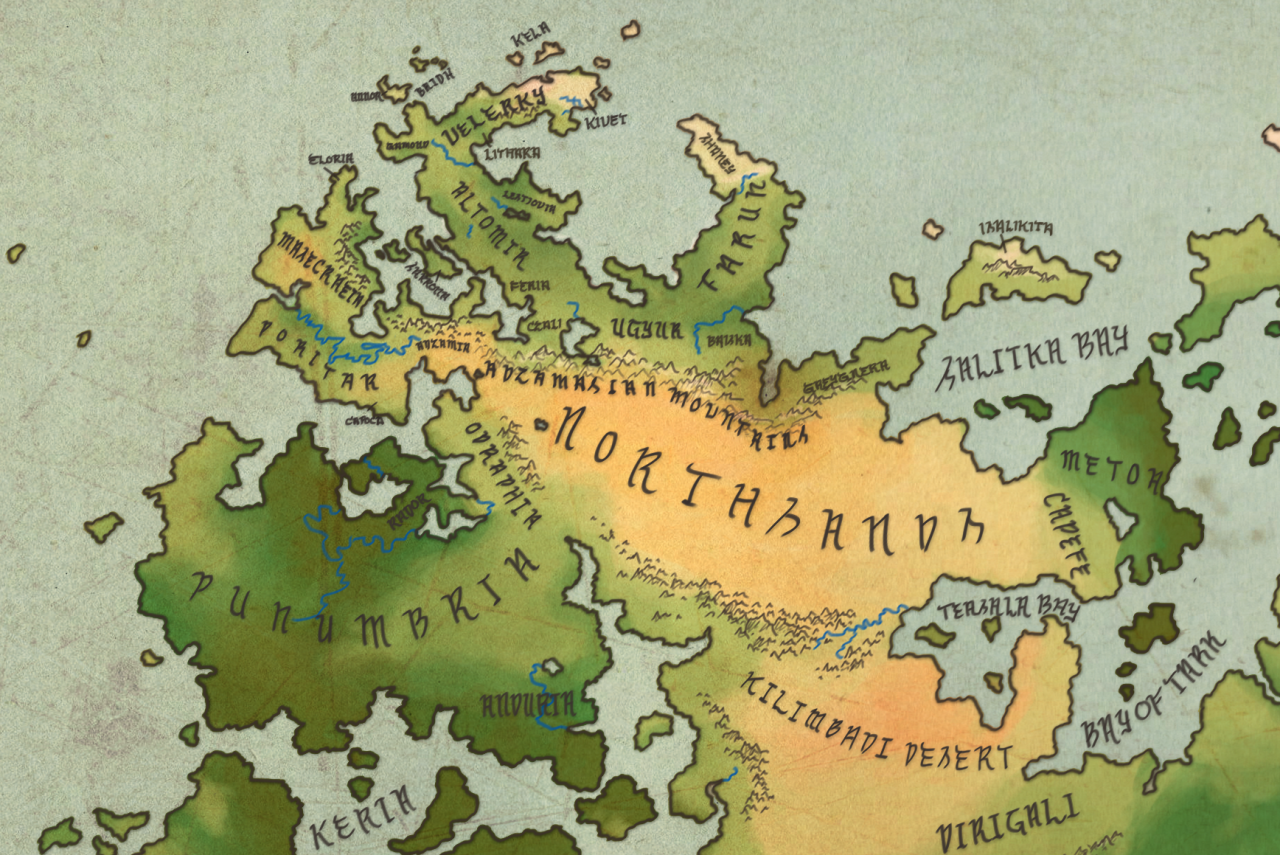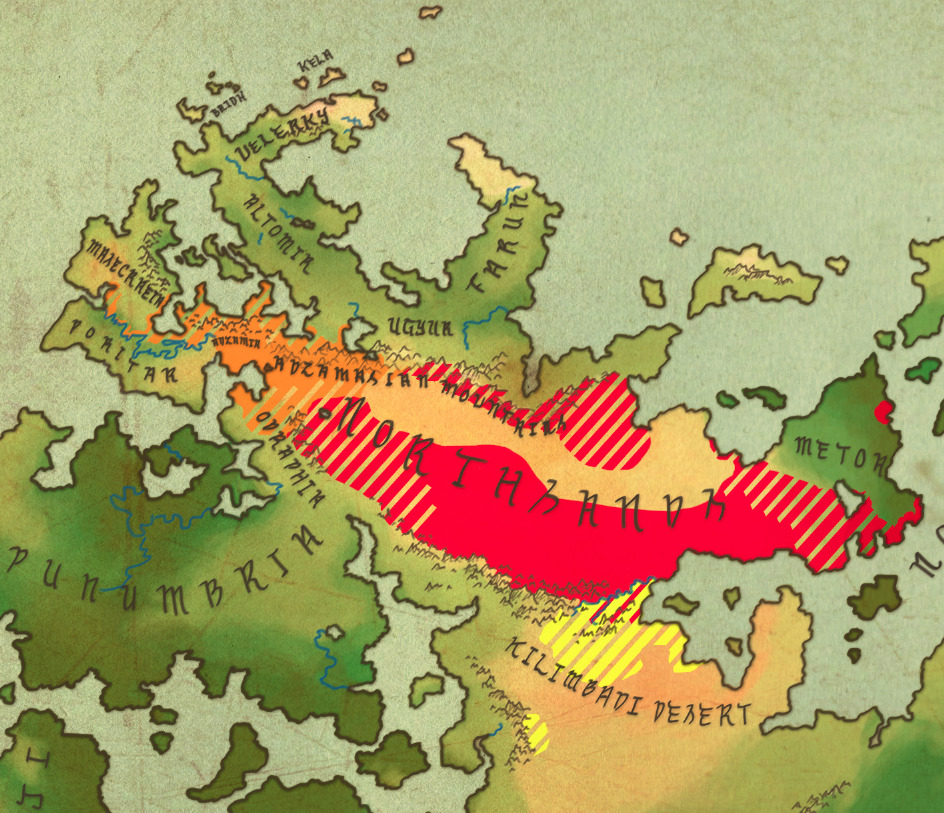Culture of the Adzamasiin (Mygith setting)
▲
5▲ 5 ▼ 0
A nomadic desert people
This public article was written by [Deactivated User], and last updated on 26 Feb 2017, 01:44.
[comments] adzadznworldbuildingculturegender
1. Adzamasi Phonology
?
?
2. Adzamian pronouns
?
?
This article pertains to the original Medieval/Fantasy setting of the Adzamasiin. Much of it still applies on Sahar but the details may differ.The Adzamasiin are a cultural group of pastorial-nomadic humans, who call the deserts of northern Mygitha home. They are well-known for many things, including their trade of fine goods and their unique religion. They are a matrilineal & matrilocal society who recognize four genders. Despite their reputation (and general success) as traders, their most important resources are the goats and fowl they keep for milk, eggs, meat, and hide.

Map of North-Eastern Mygitha. The Adzamasiin range through the Great Northsands, the Kilimbadi Desert, and into surrounding areas - as far west as Poritar and Masecraiea, east into Metoa, and south into Punumbria and Dirigali.

Dialect map of Adzamasi, which generally correspond to large cultural subdivisions as well. They are Tabiqan, Adzamian, and Kilimbadiin.
Almost all cultural Adzamasiin speak Adzamasi as their first and/or only language, although many are also well-versed in the trade creoles and other regional languages of their trade partners. There are three main dialect groups, which, by number of speakers, are the Tabiqan, Kilimbadiin, and Adzamian dialects. Tabiqan is generally considered the 'standard' dialect.
Key features of the language include its animacy hierarchy, proximity deixis, polysynthesis, vowel harmony, and a preference for heavy codas.
The Adzamasiin recognize four genders, none of which are easily translateable into the English language or usual European ways of thinking about gender. The genders are tied strongly to presentation, behaviour, identity, sexuality, and social role; like any other limited gender system, there are those who do not feel at home with their role or treatment.
The four genders are sena, sesþe, bakrar and benþi (Note that þ is also commonly written as "th" when writing otherwise in English). It is important to note that children, while they may demonstrate traits associated with one gender or another, are generally considered genderless individuals.
One can roughly sort modern Western genders as such:
- sena - has vulva+ ~feminine (feminine cis women)
- benthi - has penis+ ~feminine (trans women and feminine cis men)
- sesthe - has vulva+ ~masculine (trans men and butch cis women)
- bakrar - has penis+ ~masculine (masculine cis men)
Things are slightly more complicated, however.
By the descriptions used by the Adzamasiin, the genders can be placed into a chart like so:
| sere | abali | |
|---|---|---|
| ben | sena | benthi |
| kath | sesthe | bakrar |
Sere and abali are the Adzamasiin words for 'moon' and 'sun,' respectively. This category is best described in relation to physical sex; sere defines people with vulvas and/or who can menstruate, in contrast to abali (everyone else). Inheritance is almost exclusively passed down through sere lines.
Ben and kath mean 'water' and 'stone.' These concepts (in term of gender) are considerably more difficult to explain than sere/ abali. A few of the defining characteristics of each are:
- Ben
- "femininity"
- openness, friendliness
- pacifism, self-control, adaptability, fluidity
- submission/meekness (personal, social, and sexual)
- attraction to Kath genders
- moral uprightness; trustworthiness, faithfulness
- wisdom and common sense
- "femininity"
- Kath
- "masculinity"
- closedness, distrust
- violence, volatility, stubborn, unyielding
- dominance/assertiveness (personal, social, and sexual)
- attraction to Ben genders
- moral vagrancy; unpredictability, infidelity
- impulsivity and quick thinking
- "masculinity"
There are certainly similarities to our own stereotypes of femininity and masculinity, but these are not identical.
Approximately 15% of the population are sesthe or benthi, with the vast majority (85%) being sena and bakrar.
It is generally "required" that kath genders be attracted to and/or have relationships exclusively with ben genders, and vice-versa. Except in a few bands and/or villages which are less traditional, it is only permitted for kath-ben couples to be married, and if both members of a couple are part of the same gender group, the couple will be encouraged to split up or one member will be encouraged to take on a different gender role.
In this way, it can be said that the Adzamasiin are more accepting of what we would call "transsexuality" than "homosexuality."
There are also people who even among the Adzamasiin would be seen as gender-variant; for instance, while people we would consider transgender men would generally be considered sesthe by the Adzamasiin, they might fight to be recognized as bakrar (same for benthi vs sena). Those described as nonbinary, genderless, agender etc. might not fit into the four genders either. (In some less-traditionalist bands, a fifth gender, the quron, is recognized, which generally covers this category of people.)
The Adzamasiin usually live in groups of 50-200 individuals; nomadic bands tend on the smaller side, while the few sedentary Adzamasi villages can greatly exceed these numbers. Life for the Adzamasiin is based less on small family units and more on a community-wide structure; thus resources are shared between the community.
While there are no strictly defined castes, certain people enjoy higher respect and authority within a band.
- iltaleyön, the tolyar (chief) and family
- ilgezöön, grandmothers
- ilþeriin, priests; and ilkasariyet, mages
- guards, warriors, and artisans
- the general public
- children
- criminals
Nine times of ten, the tolyar is a bakrar; this is traditional. However, in some clans, or in exceptional circumstances, members of another gender may fulfill the role. The tera (tolyar's spouse) also has quite a bit of power and certainly commands as much respect as the tolyar.
Gender roles are thoroughly entrenched in everyday life for the Adzamasiin. Each gender has their own responsibilities to the community, traditions, rights, and possible employs. Most aspects of life are divided into four gender roles, while some are divided into two (based on kath or ben groups, or occasionally abali and sere).
Many of their gender roles are fairly similar to traditional Western roles. For instance, sena are not expected to participate in combat or hunting, and tend to have more "domestic" chores. However, there are a number of differences.
Gender roles are best explained by subdividing various aspects of life.
- Clothing
- all: cover all but face; generally loose-fitting styles
- sena: bright colours, skirts, jewellery and makeup
- bakrar: dark dull colours, leggings, cover all but eyes, high-status have jewellery
- sesthe: dark vivid colours, skirts, cover all but eyes, some jewellery
- benthi: light dull or pastel colours, leggings or skirts, jewellery and makeup
- all: cover all but face; generally loose-fitting styles
- Rights & ownership
- all: right to basic needs, to speak, possibility of becoming tera
- sn: own animals & tents; right to choose spouse
- br: own weapons & goods; right to (possibility of) being tolyar
- ss: own weapons & goods; right to priesthood
- bn: own animals & tents; right to magehood
- all: right to basic needs, to speak, possibility of becoming tera
- Combat & weaponry
- sn: non-combattants; possibly armouring
- br: patrol, raid, strategy, smith, fight
- ss: scout, raid, strategy, smith, fight
- bn: war-magic, enchanting
- sn: non-combattants; possibly armouring
- trading
- all: sell wares, supply & stock
- sn: set prices, collect earnings, distribute payment
- br: organize, protect
- ss: protect, advertise, scout
- bn: entertain, advertise
- all: sell wares, supply & stock
- food
- sn: pot, plant, harvest, forage, cook
- br: hunt, slaughter, butcher, dry meats
- ss: hunt, butcher, ferment alcohol, brew coffee
- bn: dry spices, press oils, pickle, harvest, forage, cook
- sn: pot, plant, harvest, forage, cook
- animal husbandry
- sn: herd, breed, acquire new stock, milk, collect eggs, harvest wool
- br: hunt, slaughter, butcher
- ss: herd, hunt, butcher, train
- bn: process magical components, milk, collect eggs, harvest wool
- sn: herd, breed, acquire new stock, milk, collect eggs, harvest wool
- home-keeping
- sn: clean, organize living & families
- br: erect huts, organize barracks & armory
- ss: erect huts, maintain camp, organize religious sphere
- bn: clean, thatch, organize magical sphere
- sn: clean, organize living & families
- crafts & arts (less strict than other areas)
- all: music, painting
- sn: sewing, jewelling
- br: smithing
- ss: smithing, carving
- bn: dyeing, beading
- all: music, painting
- religion
- all: worship Quuros
- sn: worship Amet
- br: worship Hasthur
- ss: worship Kkarne, 'priest'hood
- bn: worship Taali
- all: worship Quuros
- magic
- sn: healing magic (rarely)
- br: protection & combat magic
- ss: combat magic (rarely)
- bn: all magic, magehood
- sn: healing magic (rarely)
- child-minding
- sn: primary care-takers & educators
- br: protection, combat training
- ss: religious guidance
- bn: magic training, storytelling
- sn: primary care-takers & educators
The Adzamasi religion centres around the worship of five major gods and countless minor deities or spirits, called beirevah (sg. beiren). Dream interpretation is an important facet of the religion. The Adzamasiin believe that time is cyclical and that they are living in the second world, and believe in a form of reincarnation.
[wip] ✎ Edit Article ✖ Delete Article
Comments






